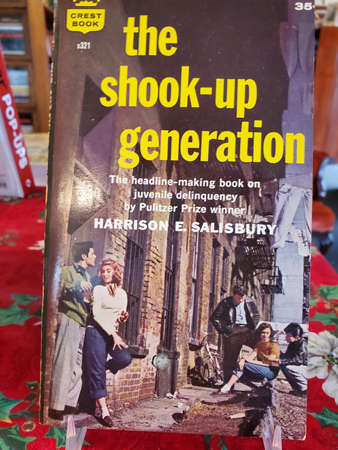Xfinity On Demand offers, under the AMC+ menu heading, a “sampler” of shows from the Sundance Channel and a “horror” channel called Shudder. Shudder has expanded horror to include paranormal and supernatural shows that aren’t particularly scary, like AMC’s A Discovery of Witches. They include the first season only.
Angelby is a Swedish paranormal show that aired in 2015. There is, according to various reports, a second season in the works, or soon to be, although since this aired six years ago, I’m dubious. Fortunately, Season One is a complete arc that wraps up most plot points in a satisfactory way.
The show is subtitled.
Warning; spoilers.
Vera Fors is newly divorced. Her husband left her for a younger woman he met at the office. As the show opens, Vera loses her job at the same office, (because obviously). Feeling hopeless, she fills out a job match website profile. Instantly–I mean, before she can finish a swallow of wine–she gets a hit, for an office manager job in the town of Angelby.
Vera packs up her daughter Tova and her son Espen and heads off for the remote forest town. Her optimism ends with a crash–literally–when she hits a person in the road during the night-time drive to the town. Terrified, Vera covers the body with branches and goes on her way. The first day in Angelby, she brazens it out, but when her eccentric new boss takes her to a social event her second night in town, celebrating the NHL recruitment of a teen hockey player–the boy Vera hit–her guilt overcomes her and she confesses to Amos, one of the town’s two local police officers. Vera takes Amos and Torsten, her new boss, to the place where she left the body, but… (have you guessed?) the body’s gone.
Before the body is found (which it will be) the story slows down and introduces us to some of the townsfolk of Angelby. There’s Vera’s weird boss, Torsten,whose generosity–he offers Vera a vacant flat he owns immediately– raises all kinds of questions. Amos is married to the blind and bitter Yvette, whose blindness is not caused by any damage to her eyes or her optic nerve, but is described in the subtitles as “traumatic blindness.” Eva, the lone school-teacher in the one-room school, is classically witchy, with plenty of secrets. Torsten’s ex-wife, Britt-Louise, has a scarred face and makes Torsten electrocute himself. (He goes along with it. Yeah, it’s a weird relationship.) At the center of the secrets and weirdness is a strange, beautiful rock embedded in the earth, out in the forest.
(I loved the rock. It looked a little bit like a giant Doritos corn chip, stuck point first into the ground. I’m sure it was a prop, but it was imposing and beautiful.)
Part of the pleasure of watching Angelby was eye candy. Lots of scenes take place in the lush forest, and the various interiors were interesting. There are lots of images of flowing water, and two scenes with a cow moose. I also liked the characters, especially as the plot progressed and we realize that all the people (with possibly the exception of Rudi) are well-developed characters whose motivations we understand. (Oh, a second exception–I never did get the deal with Yvette.)
As the story progresses, Vera’s ex, Daniel, comes back on the scene. The body of the boy she hit is found, miles from the accident site, and a mystery unfolds when it is clear he wasn’t killed by the impact with her car. Gradually, Vera realizes that it’s not a coincidence that she’s ended up in Angelby, but she still can’t figure out why. Various people, like the brothers Jakob and Marcus, provide the viewer with clues about the Stone, and Vera, and it’s clear she has some kind of Chosen One destiny.
The town is weird and the the Stone clearly conveys power, for good or bad. The story concentrates for a time on Vera’s growth, as she puts aside her self-doubt and begins to grow into herself. The Stone-related plot gets more complex as we’re introduced to astronomical calculations, Egyptian artifacts and little blond boys on bikes. Basically, at a time of planetary convergence during a lunar eclipse, something important will happen, and Vera has to be there for it. The Stone radiates power all the time, we learn, and some people, like the murdered hockey player, have absorbed it along the way… with bad results. Is the convergence good or bad? Does the Rock dispense good power, or evil, or neutral, simply filtered through the characteristics of the person who touches it? Must Vera reach out to the Stone? Some folks say yes. Should Vera avoid the Stone at all costs? Some folks say yes. Does Vera, newcomer to Angelsby, have no right to the Stone, and should she butt right out? Some folks say yes to that idea, too. Some folks even change sides in the final few episodes.
Basically, the Chosen One destiny here is one of sacrifice, not a battle or a duel with evil. It’s not an accident that after Vera has an interaction with yet another enigmatic character and undergoes a trial by ordeal, she appears dressed in while all the time, instead of the regular mundane clothing we’ve seen up ’til then.
I will pause to extol the visuals again. This show is seriously pretty. The themes are complicated, with the needs of the individual versus the needs of the group a central one. At the very end, after Vera makes her choice, I ran into some plot logic I couldn’t quite get past. Vera sacrifices herself to change the timeline of Angelby, if I understood it right. It seems like the town moved, Marvel-Cinematic-Universe-style, into an altered timeline in which many bad things did not happen. One of the things that didn’t happen was the rape that led to Vera’s conception. In the new timeline, maybe Vera didn’t come along, which would be okay, if we hadn’t seen Daniel, Tova and Espen on their way to a funeral. Daniel hugs Espen and says, “Let’s go say good-bye to your mother.” This seems like a serious plot-glitch. (It’s in there specifically to show us something about Daniel and the kids, but still…)
As I said earlier, Yvette’s story arc made zero sense to me.
Oh, I forgot to mention the show’s truly funny character, Vivecka, the other cop. While Torsten is the source of many humorous lines, he is ultimately too tortured to be funny. Vivecka, who is a loyal, smart, observant cop, is genuinely quirky and funny, and she can be because none of the plot points rest on her shoulders. (Michaela Thorsen makes the most of this character!)
I think I see where a second series might go, but I don’t know it I’d go out of my way to watch it. Still, I enjoyed Series One.




